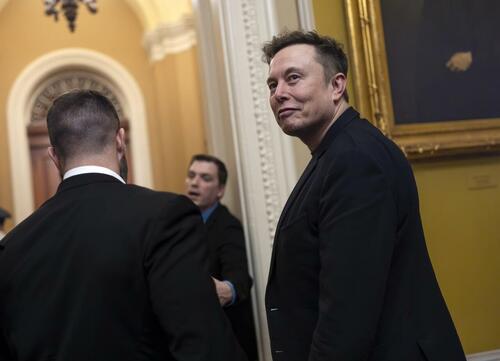Authored by J.Peder Zane via RealClearPolitics.com,
The Department of Government Efficiency noticed a snag: the sign-in button on the IRS homepage wasn’t where it ought to be. Instead of the upper right-hand corner where we, the people, have been trained to look for logins, it was stacked with other buttons in the middle of the page. It was not too hard to find, but its unusual placement disrupted the interface between taxpayers and tax collectors.
It was a simple fix.
Yet an IRS engineer reportedly estimated that it would take at least 103 days to move the button.
Thankfully, Elon Musk’s team posted last month on X:
“This engineer worked with the DOGE team to delete the red tape and accomplished the task in 71 minutes.”
If DOGE has revealed anything in its first 100 days, it is the depth of government dysfunction. While Musk’s detractors are reveling in his most obvious shortcoming – to date, it has cut an estimated $160 billion in government spending instead of the promised $2 trillion – the urgent need for reform is clear. The difficulty smart and dedicated cost-cutters are encountering in paring the mounds of federal waste is the canary crying in the coal mine.
To take a favorite word of progressives, the issues we face with government inefficiency are systemic. Fraud and abuse are real problems, but, as the IRS button example shows, the deeper issues involve what passes for standard operating procedure. We have built a leviathan that is strangling us with process.
Fred Kaplan provides a telling example in his New York Review of Books piece on Raj M. Shah and Christopher Kirchhoff’s new book, “Unit X: How the Pentagon and Silicon Valley Are Transforming the Future of War.”
As a U.S. Air Force captain, Shah was flying missions over Iraq in 2006, Kaplan writes, when he noticed that his F16’s display screen did not “indicate his location in relation to coordinates on the ground.” Back in his barracks, Shah loaded a pocket PC he had for playing video games “with digital maps and strapped it to his knee while he flew. The software in that $300 gadget let him see where he was – basic information that the gadgetry on his $30 million plane could not provide.”
A decade later, Shah was tapped to lead a small Pentagon start-up, the Defense Innovation Unit Experimental (DIUx), that sought to apply Silicon Valley innovations like the pocket PC to the military. An early challenge was coordinating the refueling of planes in midair.
Kaplan wrote that this is a “very complicated task … Yet to plan these operations, they were moving magnetic pucks around on a whiteboard, just as their forebears had done during World War II.”
He continued: “Northrop Grumman had won a contract to overhaul this system; by the time Shah saw the whiteboard, the company had spent $745 million – twice the original estimate – over ten years with nothing to show for it, and the Air Force was now asking Congress for more. ”
Kaplan reports that Shah connected with “a small Silicon Valley firm” that developed “a working product … in four months, at a cost of $1.5 million.” Needless to say, “they faced intense resistance from the Air Force officer managing the Northrop Grumman program and from staffers on the House subcommittee overseeing the defense budget.” Happily, an advocate in the Pentagon brass helped them “break through the blockage.”
No one knows how many $745 million problems can be solved with a $1.5 million solution, but it seems safe to assume that the answer is plenty. As much as DOGE has drawn attention for firing federal workers and closing a few government programs, its most significant contribution has been exposing the jaw-dropping patterns of waste and inefficiency that bloat the size and cost of government.
One more example: On March 21, DOGE reported that “the IRS has the transaction volume of a mid-sized bank, running similar infrastructure. Those banks typically have an Operations and Maintenance (O&M) budget of ~$20M/yr. The IRS has a ~$3.5B O&M budget (which doesn’t include an additional $3.7B modernization budget).” Keep that in mind when you read the next scaremongering headline about job cuts at the IRS.
Error is inevitable in human action. DOGE has certainly made mistakes. But a bigger blunder is pretending that every government worker and government contract is essential. That is the implicit argument of Musk’s detractors. Even if that risible claim were correct, our current spending trajectory is unsustainable. Something has to give.
Still, there is reason for hope. Instead of just celebrating those who found a way to move a homepage button in 71 minutes, let’s identify and eliminate the layers of bureaucracy that would have turned it into a 103-day ordeal. If software engineers can solve Pentagon problems on the cheap, let’s compile and void a list of stupidly expensive contracts – before increasing its annual budget north of $1 trillion. It can be done.
This effort might even be bipartisan. As the Trump administration has proposed funding cuts to scientific research, his opponents have argued this will kneecap one of America’s greatest strengths: our unrivalled ingenuity and know-how. Why don’t we all agree to use that dynamism to create a government as smart and effective as our nation?
Loading...
